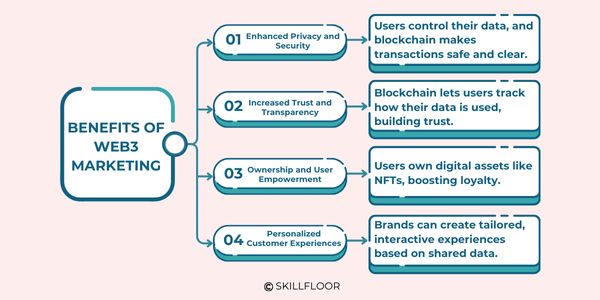What is Web3 Marketing
Web3 marketing uses blockchain, crypto, and NFTs to create decentralized and more user-controlled digital marketing. Learn how it works.

As a Digital Marketing expert, I have seen how marketing has changed over time, and one of the most exciting shifts today is Web3 marketing. Unlike traditional Web2 marketing, where large platforms like Facebook and Google control most of the data, Web3 marketing uses blockchain technology and decentralization. This allows users to have more control over their personal data and digital assets, opening up new ways for businesses to connect with customers in a more secure, transparent, and meaningful way.
In Web3 marketing, the focus is on user privacy, trust, and giving people ownership of their data. As blockchain technology continues to grow, it changes the way businesses handle customer information, ensuring it’s more secure and transparent. With tools like NFTs, cryptocurrencies, and smart contracts, Web3 marketing enables businesses to offer personalized, valuable experiences for their customers. Here, I’ll explain what Web3 marketing is, why it matters for the future, and how you can use it to improve your marketing strategies and stay ahead in the digital world.
Understanding Web3 Marketing
To know about Web3 marketing, it’s essential to understand what Web3 is and how it’s different from the current internet (Web2). Let’s break it down:
-
What is Web3? Think of Web3 as the next generation of the internet.
Unlike the current version we use (Web2), where businesses and tech giants control the flow of data, Web3 gives users control over their digital assets, identity, and information. It's built on blockchain technology, a system that records transactions across a distributed network, making it tamper-proof and transparent.
Blockchain enables Web3 to eliminate the need for intermediaries (such as banks or online platforms) by allowing peer-to-peer transactions. This creates an internet that is more decentralized, meaning no one single company or organization holds the power. Instead, control is distributed among users, which opens up more opportunities for personal ownership and transparency in online interactions.
-
Key Features of Web3:
-
Decentralization: Web3 isn’t controlled by any single organization. Instead, users and developers control decentralized applications (dApps) that run on blockchain networks. This eliminates the power of central platforms, giving users more control over their digital presence.
-
Ownership: In Web3, users own their data, digital identity, and digital assets. Unlike Web2, where personal data is often sold or used without users' consent, Web3 allows users to choose how much information they want to share.
-
Blockchain: Blockchain is the backbone of Web3. It ensures that all transactions are transparent and traceable, offering users security. Every transaction made on a blockchain is verified and logged across multiple computers, making it nearly impossible to alter.
-
NFTs and Tokenization: Web3 enables tokenization, where real-world or digital assets are represented as unique digital tokens or NFTs (Non-Fungible Tokens). These tokens can be used for digital ownership, collectibles, or as rewards, empowering users in ways Web2 never could.
The Evolution of Marketing: From Web1 to Web3
The evolution of marketing has gone through several key stages as the internet has grown and developed. From Web1 to Web3, the way businesses interact with customers has changed drastically. Here's a simple breakdown of the journey from Web1 to Web3:
|
Stage |
What it was |
Marketing Style |
Example |
|
Web1: Static Web (1990s - Early 2000s) |
Simple, static websites with no interaction. |
One-way communication, basic websites like online brochures. |
Business websites only displayed product information, no engagement. |
|
Web2: Social Web (Mid-2000s - Present) |
Interactive websites, social media, and user-generated content. |
Targeted ads, two-way communication (likes, shares, comments). |
Businesses use social media ads and interact with customers online. |
|
Web3: Decentralized Web (Future) |
Blockchain-based, user-controlled data, and decentralized apps. |
Transparent marketing, direct engagement, and rewards using NFTs & crypto. |
Brands offer NFTs or crypto rewards for customer engagement. |
How Web3 Marketing Works
Understanding how Web3 marketing works helps explain why it's becoming an important strategy for businesses. Let’s explore the core concepts:
-
Decentralized Platforms and Their Impact: Web3 marketing leverages decentralized platforms, meaning businesses don’t need to rely on tech giants to run their marketing campaigns. For example, instead of running ads on Facebook, a brand could use decentralized social platforms like Minds or Steemit, where users maintain control over their data. These platforms operate on blockchain, allowing marketers to track engagement and reward users for content creation or sharing, without the need for third-party interference.
-
Smart Contracts and Automation in Marketing: Smart contracts are a type of self-executing agreement, written in code, that automatically enforces the terms when certain conditions are met. In Web3 marketing, smart contracts are used to automate rewards and incentives. For instance, if a customer purchases a product, a smart contract could automatically send a token or NFT as a reward, cutting out the need for manual processing. This makes marketing more efficient, secure, and transparent.
-
Cryptocurrency in Web3 Marketing: Cryptocurrencies such as Bitcoin or Ethereum are integral to the Web3 ecosystem. Web3 marketing allows businesses to use cryptocurrencies to reward customer actions like sharing content or making purchases. Cryptocurrency can also serve as a form of payment for products or services, offering users a more secure, low-cost transaction method compared to traditional payment systems.
Benefits of Web3 Marketing
Web3 marketing offers several advantages over traditional digital marketing methods.

-
Enhanced Privacy and Security: One of the biggest concerns with Web2 marketing is data privacy. In Web3, users control their personal data and can choose to share it on their terms. Blockchain ensures that transactions and interactions are secure and transparent. 84% of people say they are concerned about online privacy, and Web3 can provide a solution by empowering users to control what they share.
-
Increased Trust and Transparency: With Web3, transactions are recorded on the blockchain, making everything transparent and verifiable. Users can easily track how their data is being used, which builds trust with brands. For example, brands can show their customers exactly how their purchases are contributing to a cause or how their data is being shared.
-
Ownership and User Empowerment: Web3 gives users ownership over their digital assets. For instance, a brand can offer NFTs as a way to reward customers for their engagement. These NFTs could be unique digital products, special access to content, or even a form of brand loyalty. By owning NFTs, customers feel more invested in the brand, fostering long-term loyalty. This user empowerment is key to building stronger, more engaged communities.
-
Personalized Customer Experiences: Web3 allows businesses to create more personalized, data-driven marketing strategies. Unlike traditional Web2 methods, Web3 allows users to share only the data they’re comfortable with, and brands can tailor their messages accordingly. Brands can engage users by offering rewards for actions like purchases or social media shares, creating a more interactive and personalized experience.
The Role of Web3 in Digital Marketing
Web3 is transforming the way businesses approach digital marketing. To understand its impact, it’s helpful to first look at traditional Web2 marketing, the problems that come with it, and how Web3 addresses these issues with innovative solutions.
Traditional Web2 Digital Marketing
In Web2, businesses heavily depend on centralized platforms like Google, Facebook, and Instagram for advertising. These platforms are where most businesses run their ads, targeting specific audiences based on personal data and preferences.
However, depending on these platforms comes with some important challenges:
-
Data Privacy Issues:
-
Centralized platforms gather a huge amount of personal data about users everything from what websites they visit to where they live and what they buy. While this data helps businesses target customers more effectively, it also raises concerns about how this data is used and who controls it.
-
Often, users have little control over what happens to their data, and they may not even know who has access to it or how it’s being used.
-
Ad Fraud:
-
Ad fraud is a significant problem in Web2. This happens when businesses end up paying for ads that are shown to bots (automated fake traffic) or to people who aren’t actually their target audience. This happens because it’s hard to know exactly where the ad money is going, making it difficult to trust the system.
-
Lack of Transparency:
-
Traditional marketing platforms don’t always provide a clear view of how they operate. Businesses might not fully understand how their marketing data is used or how well their ads are performing. There’s also a concern about how easy it is to manipulate ad results, making the entire system less transparent.
How Web3 Changes the Marketing World
Web3 marketing introduces a new, more decentralized way for businesses to engage with their customers. Here’s how it works:
-
Decentralized Platforms and Apps:
-
In Web3, businesses don’t have to rely on centralized platforms like Facebook or Google. Instead, they can use decentralized platforms (also known as dApps) that are not controlled by any single company. This shift allows businesses to reach consumers directly, without having to depend on a middleman.
-
With decentralized platforms, businesses can create their own communities and ecosystems where users have more freedom. It’s not about a company controlling everything; rather, it’s about creating a more open and authentic environment where customers feel in control.
-
Customer Data Ownership and Privacy:
-
Web3 gives customers ownership of their data. In traditional Web2 marketing, businesses often control and gather all user data. In Web3, users can decide how much of their data they want to share, and they have the option to receive something in return, like tokens or rewards.
-
This gives users more control over their personal information, making them feel more secure. Brands that respect users' privacy and provide clear options on how to share data can build greater trust with their audience.
-
Transparent Marketing with Blockchain:
-
Blockchain, the technology behind Web3, is designed to make everything more transparent. Every transaction or piece of data shared on a blockchain is recorded on a public ledger, making it tamper-proof and easily verifiable.
-
This means that brands can prove exactly how their marketing campaigns are working and show their customers how their data is being used. Blockchain also helps to ensure that businesses aren’t wasting money on ads that aren’t being seen by real people. It helps verify if the ads are being shown to the right audience and that businesses get what they pay for.
Examples of Web3 Marketing in Action
Many brands have already started to explore Web3 marketing, and the results are promising.
-
Brands Using Web3 Marketing: Big brands like Nike and Adidas are already leveraging Web3 to engage with their audiences in creative ways. Nike has launched exclusive NFT sneakers for collectors, and Adidas has partnered with Bored Ape Yacht Club to launch exclusive virtual items. These collaborations have helped brands tap into a new audience and create a buzz around their products.
-
NFTs in Web3 Marketing: NFTs are a key tool in Web3 marketing. Brands are using NFTs to create digital collectibles, access to exclusive events, or even as rewards for customer engagement. For example, Coca-Cola launched a series of NFTs to celebrate International Friendship Day, giving users the chance to own limited-edition digital art. These NFTs allowed Coca-Cola to create a new kind of connection with their audience, blending marketing and digital art in a way that resonated with younger consumers.
-
Community-Based Marketing with DAOs: Decentralized Autonomous Organizations (DAOs) are another unique aspect of Web3 marketing. DAOs give users the power to vote on decisions related to the brand’s direction, products, or services. Brands like Aave (a decentralized finance protocol) use DAOs to engage their community, allowing users to participate in governance and have a direct impact on the brand’s future.
Challenges and Considerations in Web3 Marketing
While Web3 marketing presents exciting opportunities, there are challenges to consider.
-
Adoption Barriers: Despite its growing popularity, Web3 is still new to many consumers and businesses. A survey by Deloitte found that only 15% of consumers were familiar with Web3 concepts like NFTs and cryptocurrency, which presents a barrier to widespread adoption. Brands will need to invest in educating their audiences about Web3 to ensure they are on board with new marketing strategies.
-
Regulation and Legal Concerns: Web3 technologies, particularly cryptocurrency and NFTs, face an uncertain regulatory environment. Many countries are still figuring out how to regulate cryptocurrencies, and brands must stay informed about potential legal issues as Web3 technologies evolve.
-
Technical Limitations: Web3 technology is still developing, and not all blockchain platforms are scalable or efficient for large-scale marketing campaigns. Businesses may encounter technical challenges, such as high transaction fees or slow processing times, especially on popular networks like Ethereum.
The Future of Web3 Marketing
The future of Web3 marketing is set to change the way businesses interact with customers in a big way. With the rise of blockchain technology, cryptocurrencies, and decentralized platforms, Web3 is making marketing more secure, transparent, and user-centered. Here’s how Web3 will shape the future of digital marketing:
-
More Control for Users: Web3 gives users control over their data, allowing them to decide what information they share with businesses. Instead of businesses collecting data without consent, Web3 lets consumers manage their personal information, leading to greater privacy and trust.
-
Personalized Experiences: With Web3, brands will be able to create more personalized experiences for customers. Through technologies like blockchain, businesses can track and reward customer interactions in ways that feel more authentic and tailored to individual preferences.
-
Decentralization of Platforms: In Web3, businesses will move away from depending on centralized platforms like Facebook and Google for advertising. Instead, Web3 allows brands to connect directly with customers through decentralized platforms, reducing the control that these large platforms have over marketing.
-
Increased Transparency: Blockchain ensures that all transactions and data exchanges are transparent and verifiable. Customers will have more insight into how their data is being used, and businesses will need to be transparent about their marketing practices. This will lead to increased trust between brands and customers.
-
NFTs and Digital Ownership: NFTs (Non-Fungible Tokens) will play a significant role in Web3 marketing. Brands can offer unique digital assets or experiences through NFTs, giving customers true ownership of digital items. This will create a new level of engagement, where consumers feel more invested in the brand’s products or services.
Web3 marketing is changing the way businesses interact with their customers by moving from traditional platforms that are controlled by big companies to a more decentralized system, where users have control over their own data and digital assets. With Web3, powered by blockchain technology, businesses can offer more transparent, secure, and personalized experiences to their customers, helping to build trust and loyalty. Brands can use tools like NFTs (digital collectibles) and cryptocurrency to reward and engage their customers in creative and new ways that weren’t possible before. As the digital world keeps evolving, businesses that adopt Web3 marketing will be able to stay ahead, connect better with their customers, and build stronger, long-lasting relationships, all while being part of a future where users have more power and control.




























































